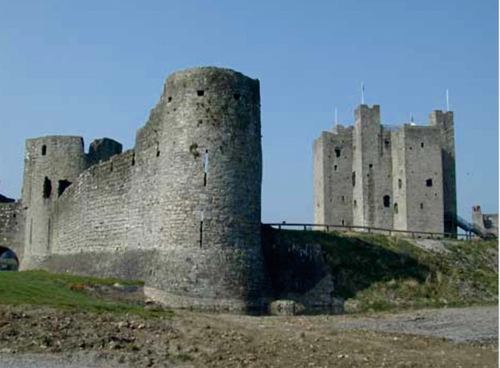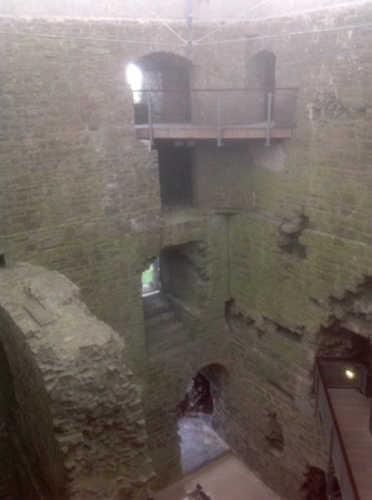A detour in Northern Island [Rogue Nomads]

This is part 30 of Dee’s grey nomad adventure around Europe. To read her previous instalment, click here
IRELAND
House sit in Enniscorthy over, we were heading to Northern Ireland; just a week until we catch the ferry from Larne, just north of Belfast. The trouble was, most of the caravan parks close by the second week in September, so we had little choice. I found a park in Dublin for our first two nights, one of the few open all year!
The next day we had quite a day, because we both wanted to go to Newgrange tombs, but on the way we stopped in Trim, and of course Trim Castle beckoned.
Of all the castles we’ve seen, I think Trim was Greg’s favourite! You can imagine yourself to be a fierce warlord, or a hairy kilt wearing chieftain, and the guided tour helped to enhance the fantasy. It has everything you need to make believe you are a dashing knight, fierce warlord, sword wielding hero, or even a medieval maiden. It’s located in the heart of the Royal County of Meath, not really far from Dublin and is the stuff of fantasy. The location scouts for the movie ‘Braveheart’ (Mel Gibson) must have agreed, as Trim Castle was used especially for fighting scenes.
Trim is the largest Anglo-Norman Castle in Ireland, built by Hugh de Lacy in the early 12th Century. Access to the castle itself is by guided tour only because it is dangerous! Now, I am somewhat vertically challenged, and the heights we ‘climbed’ to on the spiral staircases and suspended walkways, connecting the various spaces, are not for the faint hearted….and that’s me! It all became too much for me, so I bottled out one level down from the battlements, where Greg tells me you can see for miles. I can admit now: I was terrified. Going up was not too bad, but going down those spiral stairs, with just a rope to hang on to? I guess I failed that challenge!
On to Newgrange, one of the best known Irish passage tombs dating to 3200 BC, making it 500 years older than Stonehenge. There are 97 stones surrounding the tomb, which is approximately 8cm in diameter. The most impressive of these stones is the highly decorated Entrance Stone. We paid our money and took the tour. We then understood why only a few people were allowed in at a time. The opening itself was so narrow I did wonder whether I would manage to squeeze myself in! Once inside, we could see where there had been four burial chamber areas, but the highlight was when the guide switched off all the lights (pitch black!) and then we had a reenactment of what happens in December! It was …illuminating! There is a small opening or ‘roof box’ situated above the passage entrance. At dawn on the winter solstice, and for a number of days before and after, a shaft of sunlight enters the chamber through an opening in the roof box. It was an experience I wouldn’t have missed for anything.
To the Neolithic culture of the valley, the winter solstice marked the start of the New Year: a sign of nature’s rebirth and promising renewed life to crops, animals and humans. It may also have served as a powerful symbol of the inevitable victory of life over death, perhaps promising new life to the spirits of the dead. No one really knows why even to this day – I surmised that the tombs were there for ancestor worship.
Every year there’s a ‘draw’ for those people wanting to visit the site during the winter solstice and last year 50 people out of 30,000 in the draw won.
Brú na Bóinne is one of the most important prehistoric megalithic sites in Europe, and Newgrange is just one of the passage tombs. Of course it has its legends, as do the other tombs, Dowth and Knowth. The God Aengus and Newgrange are at the centre of a swan legend. Aengus falls in love with a girl he sees in a dream, named Caer. He eventually finds her after searching all Ireland for a year, but she is chained up with 150 other girls. Aengus is informed that on every other Samhain (November 1) all the girls turn into swans for a year. Aengus is told that if he can identify her when she is a swan she will be given to him. Aengus calls out to the swan that is Caer and goes over to her in the lake. As soon as he touches her he himself is transformed into a swan. The legend says that they flew together to Brú na Bóinne where they serenaded the dwellers of the tombs with their singing. Coincidentally, every winter the bend of the Boyne overlooked by Newgrange is home to swans. Romantic.
I love legends.

Have you visited this part of Ireland before? Did you visit any of these historic sites? Tell us about your travels below.










 Proudly Australian owned and operated
Proudly Australian owned and operated